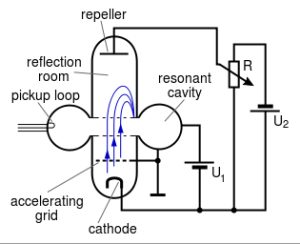
A klystron is a specialized linear-beam vacuum tube which is used as an amplifier for high frequencies, from UHF radio frequencies up into the microwave range. Low-power klystrons are used as local oscillators in superheterodyne radar receivers, while high-power klystrons are used as output tubes in UHF television transmitters, microwave relay, satellite communication, and radar transmitters, and to generate the drive power for modern particle accelerators. Klystron amplifiers have the advantage (over the magnetron) of coherently amplifying a reference signal so its output may be precisely controlled in amplitude, frequency and phase. Many klystrons use waveguides for coupling microwave energy into and out of the device, although it is also quite common for lower power and lower frequency klystrons to use coaxial cable couplings instead. In some cases a coupling probe is used to couple the microwave energy from a klystron into a separate external waveguide.
Klystrons amplify RF signals by converting the kinetic energy in a DC electron beam into radio frequency power. A beam of electrons is produced by a thermionic cathode (a heated pellet of low work function material), and accelerated by high-voltage electrodes (typically in the tens of kilovolts). This beam is then passed through an input cavity resonator. RF energy is fed into the input cavity at, or near, its resonant frequency to produce a voltage which acts on the electron beam. The electric field causes the electrons to bunch: electrons that pass through during an opposing electric field are accelerated and later electrons are slowed, causing the previously continuous electron beam to form bunches at the input frequency. To reinforce the bunching, a klystron may contain additional “buncher” cavities. The RF current carried by the beam will produce an RF magnetic field, and this will in turn excite a voltage across the gap of subsequent resonant cavities. In the output cavity, the developed RF energy is coupled out. The spent electron beam, with reduced energy, is captured in a collector.
To make an oscillator, the output cavity can be coupled to the input cavity(s) with a coaxial cable or waveguide. Positive feedback excites spontaneous oscillations at the resonant frequency of the cavities.
References
- Robert R. Weirather; The Electronics Handbook, 2nd ed., pages 482-489. (2005).
- George Caryotakis (November 18, 1997). “Invited paper: The Klystron: A microwave source of surprising range and endurance”. American Physics Society: Division of Plasma Physics Conference, Pittsburgh, PA.
(Extracted from Wikipedia.com.)
